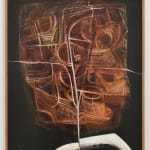



Robert Ellis
River Bend and City, 1964
oil on hardboard
905 x 698mm
930 x 725mm framed
930 x 725mm framed
Further images
Robert Ellis grew up in post-war England, a landscape shaped by industrialization and reconstruction. He initially trained as a graphic designer, studying at Northampton School of Art and the Royal...
Robert Ellis grew up in post-war England, a landscape shaped by industrialization and reconstruction. He initially trained as a graphic designer, studying at Northampton School of Art and the Royal College of Art in London. His training gave him a solid foundation in drawing and design, but it was during his time in London that Ellis began to gravitate toward painting. His move to New Zealand in 1957 marked a turning point in his artistic career. Ellis took up a teaching position at the University of Auckland's Elam School of Fine Arts, where he taught for over three decades, significantly influencing younger generations of New Zealand artists.
Cityscapes—or more specifically city lights, streets, motorways and waterways—became an enduring subject in Robert Ellis’ oeuvre and dominated his works from the early 1960s to mid-1970s. River Bend and City is a notable work from the series, painted in 1964 when he was well established in this theme. Unlike the earlier works, which included horizon perspectives, River Bend and City is purely an aerial perspective showing a city engulfed and enclosed by the surrounding darkness. This perspective abstracts the city, reducing it to a network of lines, shapes, and colours, making the urban environment feel simultaneously familiar and alien.
As Hamish Keith wrote in a Barry Lett Galleries catalogue from 1965, “Robert Ellis offers us a vision of the city as it may be – were man to leave it entirely to its own devices…The city is built in the image of man. In Ellis’ painting this image is endowed with an organic life of its own. Here the city is not what man has fashioned, it is what the city has made itself.”
References:
1. Hamish Keith, “Robert Ellis”, Barry Lett Galleries catalogue, 1965
Cityscapes—or more specifically city lights, streets, motorways and waterways—became an enduring subject in Robert Ellis’ oeuvre and dominated his works from the early 1960s to mid-1970s. River Bend and City is a notable work from the series, painted in 1964 when he was well established in this theme. Unlike the earlier works, which included horizon perspectives, River Bend and City is purely an aerial perspective showing a city engulfed and enclosed by the surrounding darkness. This perspective abstracts the city, reducing it to a network of lines, shapes, and colours, making the urban environment feel simultaneously familiar and alien.
As Hamish Keith wrote in a Barry Lett Galleries catalogue from 1965, “Robert Ellis offers us a vision of the city as it may be – were man to leave it entirely to its own devices…The city is built in the image of man. In Ellis’ painting this image is endowed with an organic life of its own. Here the city is not what man has fashioned, it is what the city has made itself.”
References:
1. Hamish Keith, “Robert Ellis”, Barry Lett Galleries catalogue, 1965


